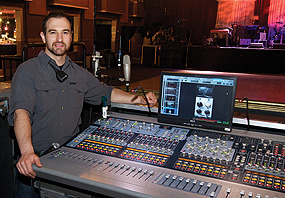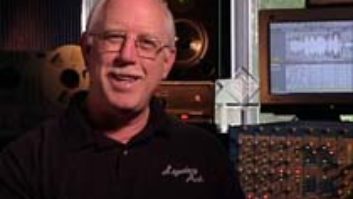
Grammy-winning singer/songwriter Norah Jones is back on the road to support The Fall. Accompanied by a stellar backing band, this usually mellow artist brought an energetic, riveting and incredible-sounding show to San Francisco’s Fillmore.
Front-of-house engineer Brett Dicus mans a 48-channel Avid D-Show Profile configured with five DSP cards, HDx and ECx. “I chose this desk because of its reliability, automation, plug-ins and the very useful and utilized feature of it being a VNC server, which provides control from any of my computers or tablet computers. We use every channel, plus I have a few pre’s for additional channels of audience mics.” Onboard plug-ins include Waves C4 (vocals/bass), McDSP, Elysia, Crane Song and Flux. “These give me the control I need to consistently adapt to the wide range of rooms we are playing,” Dicus explains.
Front-of-house engineer Brett Dicus mans a 48-channel Avid D-Show Profile configured with five DSP cards, HDx and ECx.
The Audio Analysts–supplied Meyer Sound P.A. comprises 24 MICA line array boxes, six HP700 subs, 12 CQ-2s for near- and side-fills, and six M1Ds as front-fills. According to systems engineer Spencer Ellis, “We are feeding all of the separate zones via AES into two Galileo 616s [main and spare] with a backup analog feed coming from monitor world.” At FOH, Ellis’ workstation includes two Apple Mac Minis running Windows: Computer A has Smaart and Meyer Sound’s RMS; Computer B runs Meyer Sound’s Compass, which he uses for system EQ and delaying zones. He sends two RTA mics to Smaart via Sound Devices’ USBPre: one hardwired and one via Lectrosonics wireless.

Four members of the band do a little jam at the end of the show surrounding a Neumann TLM103 mic. Dicus has a Waves Q10 inserted on the channel, as well as the strip EQ to help eliminate feedback and then to contour the tone.
According to tech Kelly Macaulay, Jones also plays a Wurlitzer 200 that is run through a Sans Amp Classic to get the overdriven sound into a Keeley-modified Ibanez analog delay pedal into her Vox Pathfinder 15R amp.
Smokey Hormel’s guitar runs through about 14 pedals, including a Fulltone wah, Hot Cake and analog delays. That signal is driven by two amps: a ’63 Fender Deluxe with a Shure SM7 mic and a ’73 Fender Twin with a Shure SM57 mic.
Jones uses two Vox Pathfinder 15R amps: one at the guitar position (miked with a TLM103) and the other at the Wurlitzer position amp (Shure KSM32). These are mounted to the amp with a custom Audio Analysts Z-bar. Vocal mic is a Neumann KMS104.

Monitor engineer John “Boo” Bruey mixed on a 48-channel Avid D-Show Profile using only one instantiation of a noise generator to help test the system.
Monitor engineer John “Boo” Bruey mixed on a 48-channel Avid D-Show Profile using only one instantiation of a noise generator to help test the system. “This show, mostly with [Audio Analysts SLP] wedges in use, does not require much beyond what the channels strip has to offer,” Bruey says. “Every bandmember has a wedge mix; however, the vocalists have in-ears available that occasionally get used for TV and arena dates. The band is set up very close together onstage so they can hear each other and the house. This works out well for me because our stage levels end up being lower with a more controlled monitor mix.”
Bassist Gus Seyffert plays an Electric Sunn 1200 with 1×15 cab and miked with a 421. His upright is a Sunn 2000s with 2×15 cab miked with a Shure SM7.
Sasha Dobson’s Gibson ES-125T electric guitar runs through a Boss Digital Delay into a Fender Deluxe Reverb amplifier. Her acoustic Martin runs through a SansAmp parametric DI. Banjo is a Deering 6-string that goes through a second parametric DI. Percussion is a soya bean oil can mounted on a DW 6000 Series snare stand and a “kit” comprising a 16-inch pawnshop floor tom and a CB 14-inch chrome snare covered with black cloth to deaden them.
John Kirby plays six keyboards, in addition to the Harmonium and Marimba. (The Harmonium is miked with a KSM32 while Marimba takes two Sennheiser e 904s that are “Y’d” together to capture all of the notes to be available in one mono input.) According to keys/guitar/drum tech Futz (above right, with guitar/bass tech Brian Gibney), “Most of John’s sounds come from two mid-‘80s Casio sampling keyboards [SK-1 and SK-5]. The SK-1 runs through an Electro Harmonix Holy Grail Reverb and then to a Radial JDI passive direct box. The output of the SK-5 is sent to a Danelectro Dan-Echo Analog Echo, then to an Ernie Ball Mono Volume Pedal, followed by a Behringer mixer with built-in effects that sends the signal to a Trek II UC-1A footswitched preamp that drives a Leslie 147 rotary speaker cabinet.”
The organ is a ‘60s Realistic Musideck that is sent through an Ernie Ball Mono Volume Pedal, then through the mixer where the signal splits to the Leslie and to one side of a ’70s Fender Bassman Amplifier (for solo parts). On top of the Musideck is a Roland JX-3P keyboard that runs through another Holy Grail Reverb and then to a second Radial JDI passive direct box. “We also have a stock ’70s Wurlitzer 200A electric piano going through a Boss BD-2 Blues Driver (for extra crunch) and an Ibanez AD-9 analog delay before going to the bass input of the Fender Bassman,” says Futz.
The Yamaha Spinet Piano comprises five inputs and some compression. Dicus uses two KM184s inside to capture the natural tone and noises around the hammers and strings. Inside is an installed Helpinstill Upright pickup. On the back of the piano are two Barcus Berry B4000XL-P planar wave pickups (pictured). “The Helpinstill pickup was added later in the tour to help give monitors a consistent mono input that contains all of the piano notes,” Dicus explains. “The pickups and the mics work very well; however, the Helpinstill helps capture the low-mid of the piano. At FOH, I have all of this bused to a stereo group that is then processed with a [Waves] C4, Q6 and Rcomp.”


